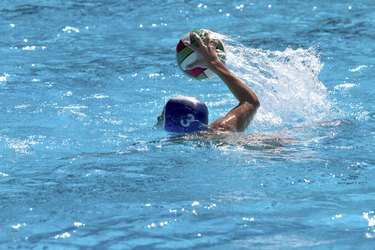
If you're a water polo enthusiast or need to swim effectively without submerging your face, swimming with your head up is essential. It lets you remain aware of your position and the goal while you swim. Individuals trained in lifesaving and ocean rescue also swim with their heads up so they never lose sight of the person they're trying to rescue.
Shoulder Roll
Video of the Day
Swimming traditional freestyle stroke with your head in the water involves rotating your torso. This rotation also lets you turn your head to the side as you breath. Swimming with your head up requires reducing your shoulder rotation while keeping your head stable. Use the tops of your shoulders as pivot points as you extend your arms during each stroke, but don't allow your head to swivel as you do so.
Video of the Day
Hip Rotation
When you swim with your head above water, your hips become a virtual steering paddle for the rest of your body. Maximizing your hip rotation helps streamline your body through the water. Rotate your hips as far as possible toward whichever arm is currently stroking through the water. For example, when your left arm takes a stroke, your left hip bone should be perpendicular to the bottom of the pool. Rotating your hips completely with each stroke reduces the strain on your shoulders and makes it less taxing to hold your head above the water line.
Shorten Your Strokes
Whenever your body isn't flat in the water, like when you're swimming with your head up, your lower half starts sinking. The standard freestyle stroke ends at your hip, but doing this with your head up would cause your lower half to lose momentum. Shortening your arm strokes so they end at the bottom of your torso instead of your hip prevents you from sinking. For effective propulsion, your shorter strokes must be powerful and rapid to compensate for the reduced length.
Kick Hard
Use your entire leg to produce a powerful flutter kick that prevents your lower half from sloping down in the water when your head is up. A proper flutter kick produces little splash because your feet are submerged entirely. Kicking underwater moves more water, which builds more momentum. Kicking your feet at the surface is a waste of energy because half of what you're moving is air, which won't increase your swimming speed. Maintaining a rhythmic, fluid motion from your thigh through your foot helps propel your body through the water despite the position of your head.